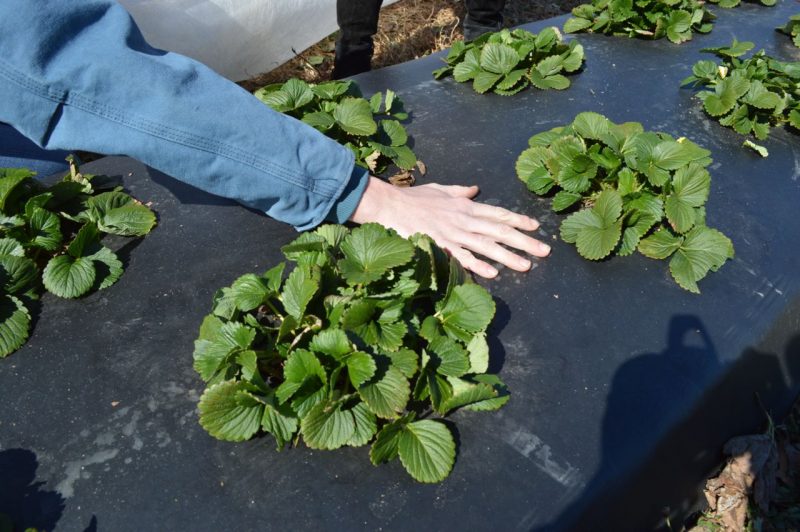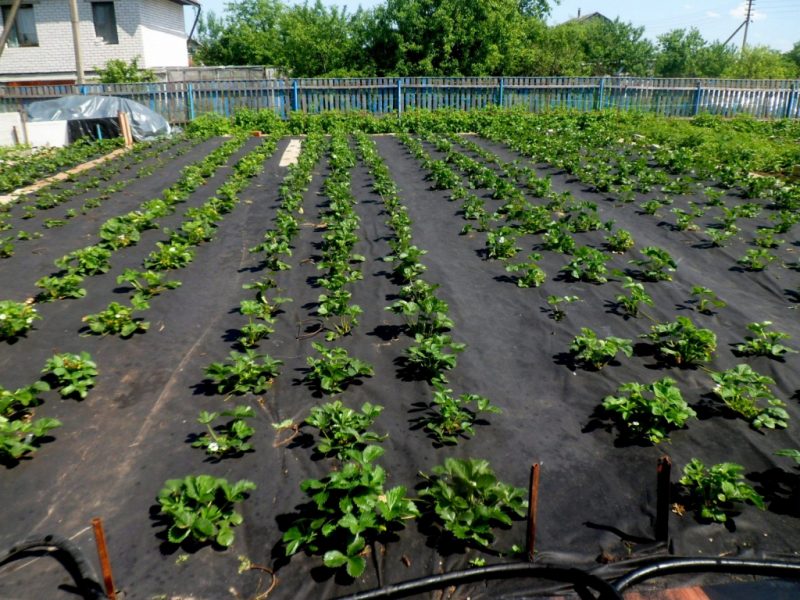If you use covering material for strawberries, you can get a good harvest with the least effort and without the use of harmful "chemistry". Coming to the garden center, you need to clearly understand what exactly you want to buy, for what purposes you need material, then the purchase will be successful.
Material Content:
Types of cover material for strawberries
Covering non-woven material helps protect strawberries in unstable weather conditions. There are different types of it, intended for certain purposes.
When choosing a covering material, you must pay attention to the fact that it contains ultraviolet stabilizers. This will protect it from rapid destruction in bright sunshine, and extend the life of up to 3 years.
The density of the covering material is also important.
There are such types:
- 17 g / m (the thinnest spanbond) - used to shelter plants from sunburn;
- 30 g / m - they can cover the sown lawn grass so that the seeds are not washed away by the rain, and they are not pecked by birds or protect plants from sunburn;
- 42 g / m - protects plants from a slight cooling at night and heat during the day;
- 60 g / m (one of the densest spunbond) - used to protect seedlings from night frosts, as well as to shelter plants for the winter.
All types of covering material transmit moisture and air well. Strawberries like this, it gives a good harvest.
Cover material also helps in weed control. Thanks to this, you can get an environmentally friendly crop, without making much effort. The usual black agrofibre, the so-called mulch, helps in this.This material has a high density of 60 g / m and should last at least 3 years.
The difficulty for some gardeners is that agrofibre needs to be fixed, then holes should be made. To facilitate the task, the manufacturer produces a special covering material for strawberries with holes already made.
There is black and white mulch. The bottom layer is black, it is laid on the ground, and prevents the growth of grass, and the top one is white, reflects more light. One of the most interesting mulching materials is black and yellow. It is difficult to first understand why it is needed. The black layer is used traditionally; it prevents weeds from growing. The yellow top layer, it turns out, confuses insect pests, it allows you to grow crops without chemicals.
Advantages and disadvantages
For some gardeners, the priority material on which they grow a good crop is a film for mulching strawberries. It is cheap but short-lived. Agrofibre is more expensive, and has its own operating features, which are useful to get acquainted with before buying.
The advantages of non-woven material are that it allows you to reduce labor costs when caring for strawberries - you do not need exhausting weeding and frequent watering. It protects the roots of plants from overheating in the summer and cold in the winter, helps to keep the crop from slugs and rot.
The first inconvenience you have to face is planting seedlings. If you make a large cut or hole on the agrofibre, sunlight will penetrate through it, weed seeds will begin to germinate. Therefore, when landing, it is necessary to minimize incisions. They should be small, and at the same time allowing planting seedlings without damaging the root system.
The second inconvenience is watering. Agrofibre allows water to pass through, but if you pour half a bucket of water under the plants, the moisture will not immediately go away. It will stay on the surface, if a strong wind blows, the puddle will roll over the surface. It is most convenient to use drip irrigation, laying hoses with holes throughout the entire area. It can also be watered with sprinklers.
Strawberry Planting Rules
To plant strawberries under the black covering material, they begin by digging the soil, do it especially carefully. All weeds are picked, dug up. Fertilizers are added to the garden; it is best to use manure and wood ash.
Having leveled the plot with a rake, they remove all stones and irregularities, watered with water. When the bed is ready, you can spread the covering material. If the agrofibre is black on both sides, it does not matter how to spread it on the soil. Black and white material is laid with the black side facing the ground, and white toward the sun.
After the material is laid out throughout the garden, they begin to fix it. To do this, use studs made of old wire or apply flexible electrodes. Fix around the perimeter, pinning the edge of the agrofibre to the ground. Now the bed is ready for planting strawberry seedlings.
Make preliminary markings using twine or a pole and chalk. Holes are planned for seedlings at the same distance of 25-30 cm. The rows are convenient to make in a checkerboard pattern, so more light will come into the seedlings and airing will improve.
Cross-shaped incisions are made in agro-fiber marked in chalk. Further, it is convenient to use a landing cone for the device of holes, but if it is not there, a small shovel will do. Strawberry seedlings are placed in each hole; it cannot be deeply buried during planting. Then spread the covering material around the plant. All planted plants are watered by sprinkling spunbond.
Mulching Technique Using Covering Materials
Before putting geotextiles on the ground, the site must be carefully weeded, loosened and leveled so that there are no large depressions. They can collect moisture after rain.
Planting strawberries under cover material is not difficult - you need to correctly mark and cut holes, and place seedlings in them.
If the plants have already been planted on the site, you can cover them with a cloth from above, and, making in the place where they are cross-shaped cuts, carefully remove them. To fix the material using iron studs or decorative stone.
Berry Care Activities
The advantage of agrofibre is the retention of moisture in the soil, so the effort and expense of water for irrigation are reduced. The black color of the material is misleading, it seems that it attracts the sun's rays. In fact, when it is very hot, the soil covered with spanbond is preserved from overheating, the root system of plants does not suffer. Mulching strawberries is very convenient.
Nothing grows under the agrofibre, when harvesting it is clearly visible that weeds appear where there are openings for plants. Agrofibre saves energy and time on caring for plants: watering, cultivating the land from weeds, loosening, get a good harvest even in rainy weather.

















